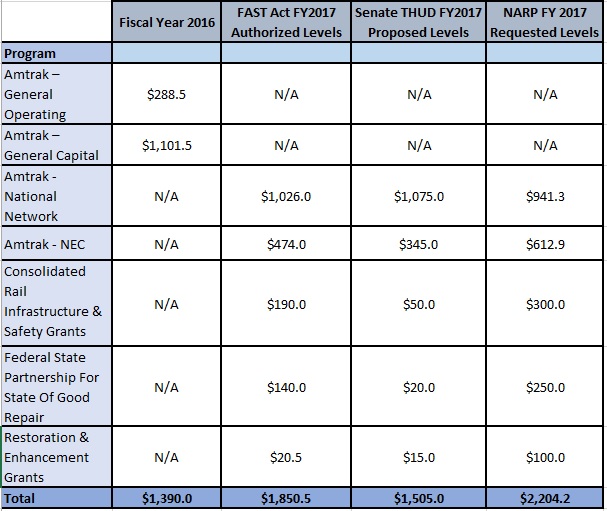Happening Now
NARP Applauds U.S. Senate for Increased Funding to Support Passenger Rail
April 19, 2016
Release #16-08
For Immediate Release (#16-08)
Contact:
Robert Brady – (202) 680-4951
Rail Advocacy Group Calls for Full Authorization of FAST Act
[Updated April 19, 3:15pm Eastern, to reflect more detailed numbers released by the Senate Appropriations Committee]
Washington, D.C. – The National Association of Railroad Passengers applauds the U.S. Senate Appropriations Subcommittee on Transportation, Housing and Urban Development’s (THUD) decision to increase funding for passenger rail to $1.7 billion, $76 million above the FY2016 enacted level. The committee also provided $525 million for TIGER grants (also known as National Infrastructure Investments), $25 million above the FY2016 enacted level; and $2.3 billion for Capital Investment Grants (New Starts). Both programs have been extremely successful in funding investment in rail transit.
Following THUD’s support, NARP is asking its 28,000 members, along with the almost 40 million Americans who rely on intercity and commuter rail every year, to thank their Senators for increasing funding to trains—while simultaneously pushing appropriators to increase funding for rail to fully authorized levels established by the Fixing America’s Surface Transportation (FAST) Act.
NARP is requesting $2.2 billion for passenger rail in Fiscal Year 2017, based upon the programs overwhelmingly approved by Congress as part of the FAST Act, as well as Amtrak’s FY2017 funding and reauthorization request. While this figure falls short of the pressing need for capital investment facing rail systems across the U.S., it does represent a meaningful increase from the $1.39 billion enacted for Amtrak for FY 2016. At the minimum, Congress should provide the $1.85 billion it overwhelmingly voted to authorize as part of the FAST Act just last year.
“The fact that Chairwoman Collins and Vice Chairman Reed are able to work across the aisle to find this additional funding in a tight budgetary environment is a testament to the growing recognition of the need for additional investment in transportation infrastructure,” said NARP President Jim Mathews. “But we need to go further and fully support the rail programs approved by Congress in the FAST Act to address growing congestion in other modes, as well as rapidly dwindling transportation options in small- and mid-sized communities. These factors are driving the surge in public demand for trains, making train travel more vital than ever to local economies across the nation.”
The full Senate appropriations Committee is scheduled to markup the THUD bill on April 21st, where individual amendments will be permitted.
A breakdown of proposed rail funding from NARP is included for reference.

[The Senate THUD FY2017 Proposed Levels bill summary identified $334 million for Rail Safety & Research Programs, not completely accounted for in this table; the total funding level identified by the Committee is $1.7 billion.]
About the National Association of Railroad Passengers
NARP is the only national organization speaking for the nearly 40 million users of passenger trains and rail transit. We have worked since 1967 to expand the quality and quantity of passenger rail in the U.S. Our mission is to work towards a modern, customer-focused national passenger train network that provides a travel choice Americans want. Our work is supported by more than 28,000 individual members nationwide.
###
"The COVID Pandemic has been and continues to be the biggest challenge faced by Americans as it has taken a deadly toll on the world and on the world’s economies. During COVID Locomotive Engineers at Amtrak and other Passenger and Freight Railroads have embodied the definition of essential workers. This dedication by our members is not new. We applaud the Rail Passenger’s Association for recognizing the vital contributions of our members and their hard work moving Americans and freight during the COVID pandemic."
Dennis Pierce, Brotherhood of Locomotive Engineers and Trainmen (BLET) National President
December 21, 2021, on the Association awarding its 2021 Golden Spike Award to the Frontline Amtrak Employees.
Comments